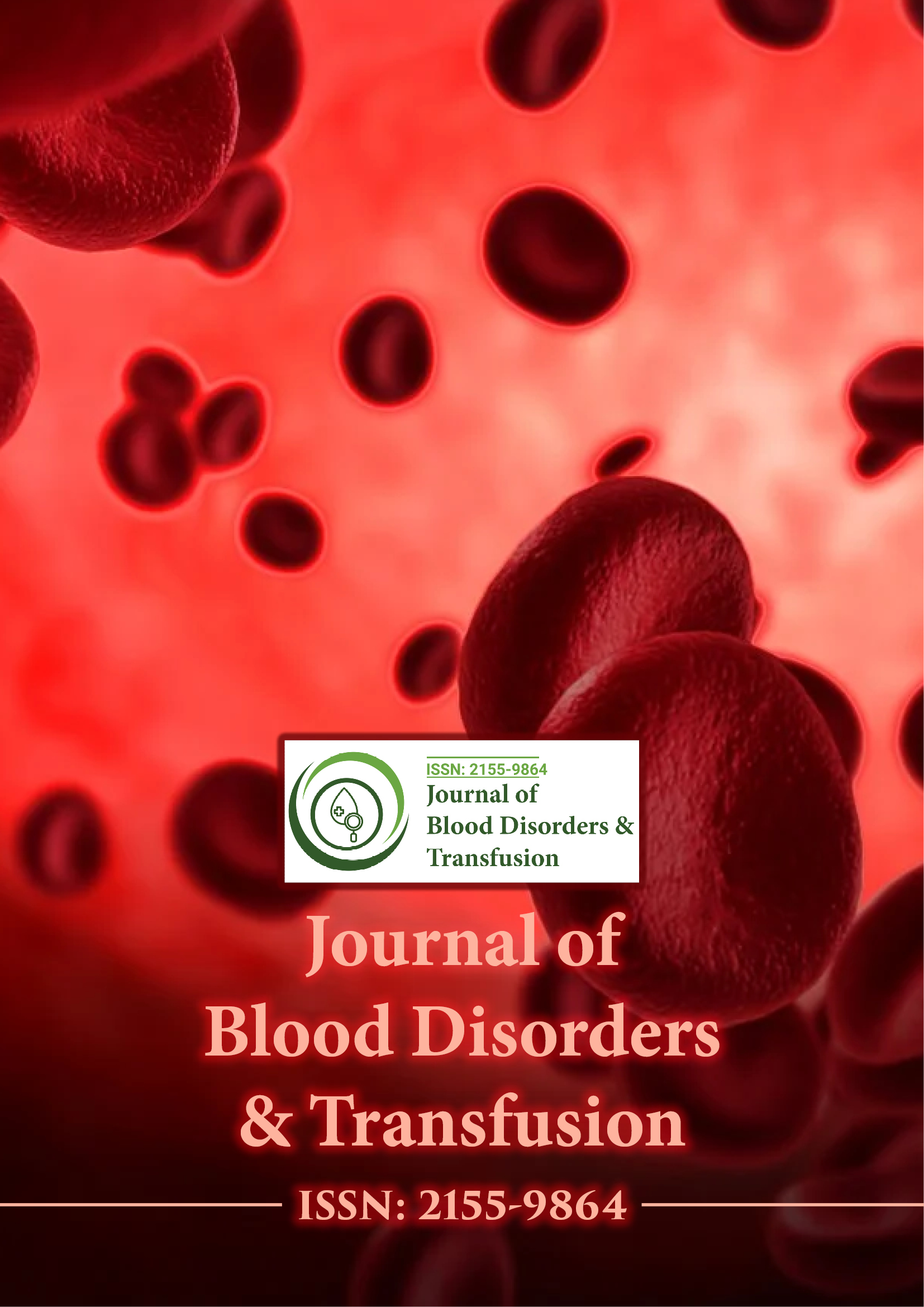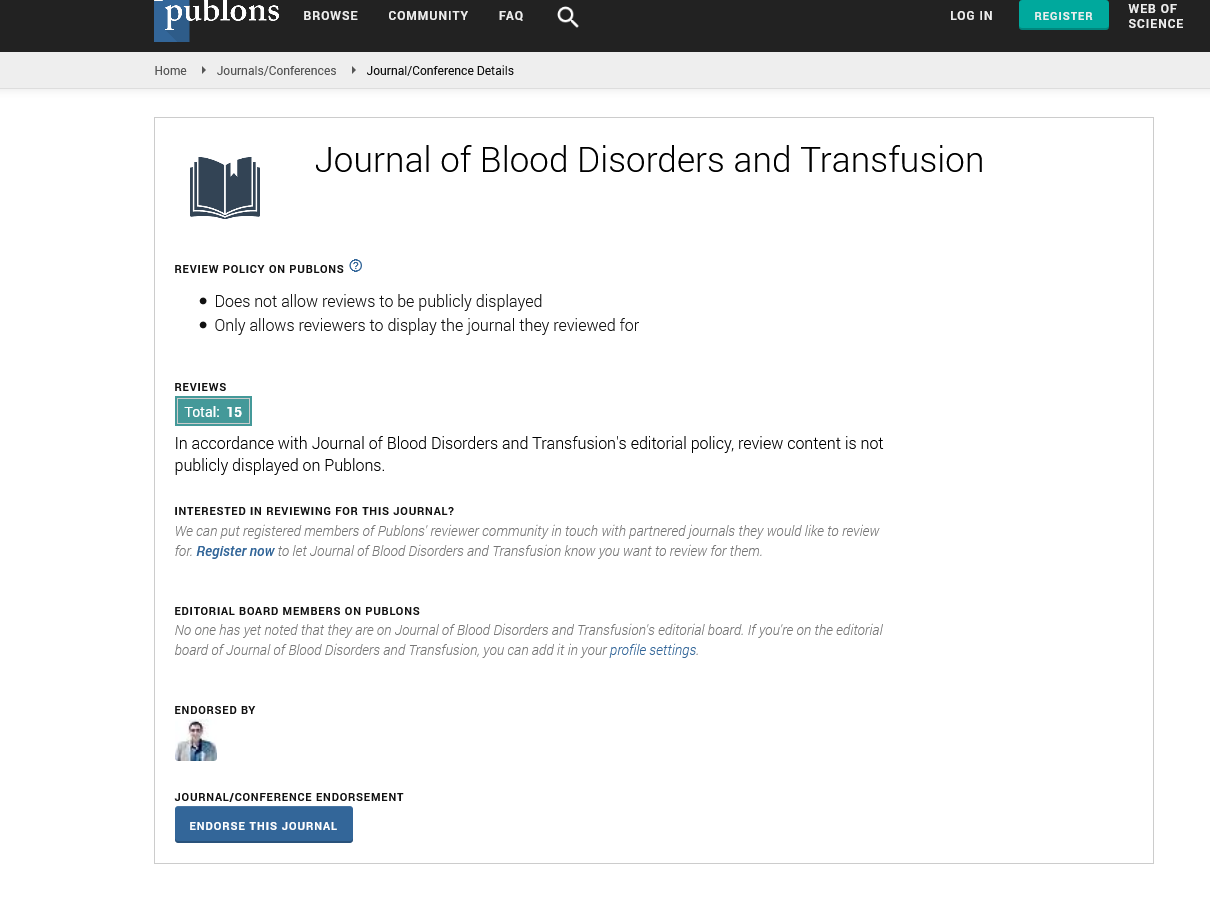Indexed In
- Open J Gate
- Genamics JournalSeek
- JournalTOCs
- Ulrich's Periodicals Directory
- RefSeek
- Hamdard University
- EBSCO A-Z
- OCLC- WorldCat
- Proquest Summons
- Publons
- Geneva Foundation for Medical Education and Research
- Euro Pub
- Google Scholar
Useful Links
Share This Page
Journal Flyer

Open Access Journals
- Agri and Aquaculture
- Biochemistry
- Bioinformatics & Systems Biology
- Business & Management
- Chemistry
- Clinical Sciences
- Engineering
- Food & Nutrition
- General Science
- Genetics & Molecular Biology
- Immunology & Microbiology
- Medical Sciences
- Neuroscience & Psychology
- Nursing & Health Care
- Pharmaceutical Sciences
Opinion Article - (2025) Volume 0, Issue 0
Anaemia and Patient Blood Management in Modern Healthcare
Marco Freireich*Received: 26-May-2025, Manuscript No. JBDT-25-28663; Editor assigned: 28-May-2025, Pre QC No. JBDT-25-28663 (PQ); Reviewed: 11-Jun-2025, QC No. JBDT-25-28663; Revised: 18-Jun-2025, Manuscript No. JBDT-25-28663 (R); Published: 25-Jun-2025, DOI: 10.4172/2155-9864.25.S14.070
Description
Anaemia remains a widespread public health issue, particularly in developing nations, affecting individuals across various age groups and socioeconomic backgrounds. It is characterized by a decrease in the number of red blood cells or a deficiency in haemoglobin, which impairs the oxygen-carrying capacity of the blood. Causes of anaemia vary and include nutritional deficiencies, chronic diseases, infections and genetic disorders. Traditionally, the treatment of anaemia often involves the use of blood transfusions. While transfusions can be life-saving, they are associated with potential complications and should be used judiciously. In recent years, there has been a shift towards incorporating Patient Blood Management (PBM) into healthcare practices. PBM is a multidisciplinary, evidence-based approach aimed at optimizing the care of patients who might need transfusion.
Understanding anaemia
Anaemia can be classified based on its cause and morphology. Iron deficiency anaemia is the most common type and often results from poor dietary intake, chronic blood loss, or increased physiological demands. Other types include vitamin B12 and folate deficiency anaemia, anaemia of chronic disease, aplastic anaemia and haemolytic anaemia. Each type has distinct pathophysiological mechanisms and treatment modalities.
The consequences of untreated or poorly managed anaemia are significant. In children, it can impair cognitive and physical development. In adults, it leads to reduced work capacity, fatigue and increased susceptibility to infections. During pregnancy, anaemia contributes to maternal and perinatal morbidity and mortality. The burden on healthcare systems is also notable, with increased hospitalizations and prolonged recovery times.
Role of lood transfusion in anaemia management
Blood transfusion plays a vital role in managing severe anaemia, especially when there is an immediate risk to life or when symptoms severely impair quality of life. Indications for transfusion are typically based on haemoglobin thresholds, clinical symptoms and underlying conditions. However, overreliance on transfusions can lead to various complications, including transfusion reactions, alloimmunization, transmission of infections and iron overload.
In resource-limited settings, the availability of safe blood is often a challenge. This adds to the complexity of anaemia management, where clinicians must balance the need for immediate correction of haemoglobin levels against the potential risks and scarcity of blood supplies.
Patient blood management
Patient Blood Management (PBM) has emerged as a strategy to address the limitations associated with traditional transfusion practices. It is built upon three core pillars: optimizing red blood cell mass, minimizing blood loss. PBM involves a coordinated effort among clinicians, nurses, transfusion specialists and hospital administrators.
The first pillar, optimizing red cell mass, involves identifying and treating anaemia before it becomes severe. This may include iron supplementation, use of erythropoiesis-stimulating agents, and management of underlying conditions. Preoperative screening for anaemia and timely intervention are integral to this approach.
The second pillar focuses on minimizing blood loss during medical and surgical procedures. Techniques include the use of minimally invasive surgical methods, proper haemostatic management and intraoperative blood conservation techniques such as cell salvage. Pharmacological agents like antifibrinolytics are also employed to reduce bleeding.
Benefits of atient lood management
Implementing PBM has demonstrated significant improvements in clinical outcomes. Patients undergoing PBM-guided care experience fewer transfusions, lower infection rates, reduced incidence of complications and shorter hospital stays. These benefits are particularly evident in surgical populations, such as those undergoing cardiac or orthopedic procedures.
From a systemic perspective, PBM contributes to better resource utilization. Reduced demand for donor blood alleviates pressure on blood banks and lowers healthcare costs associated with transfusion-related complications. Additionally, it supports ethical principles by ensuring that blood is used where it is most needed and with the greatest benefit.
Citation: Freireich M (2025). Anaemia and Patient Blood Management in Modern Healthcare. J Blood Disord Transfus. S14:070.
Copyright: © 2025 Freireich M. This is an open-access article distributed under the terms of the Creative Commons Attribution License, which permits unrestricted use, distribution, and reproduction in any medium, provided the original author and source are credited.

